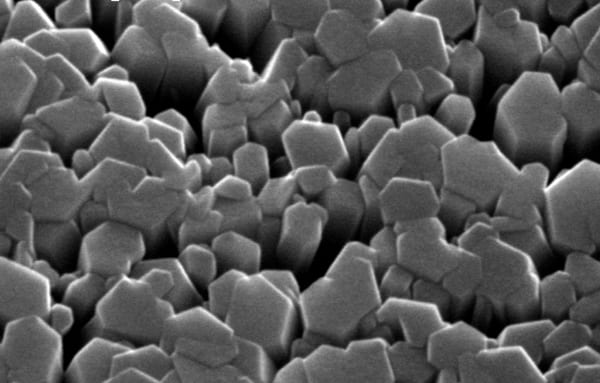By Steve Dunn, Queen Mary University of London, and James R. Durrant, Imperial College London
Solar energy is our most abundant renewable energy resource. As such, the development of low cost, scalable strategies to harness this resource is of increasing interest. The most familiar application of solar energy conversion is a photovoltaic cell which converts sunlight into electricity, although plants have reliably converted sunlight using photosynthesis for billions of years, and there is increasing interest in artificial photosynthetic strategies. Whilst many photovoltaic systems are commercially available, based primarily on crystalline silicon, there is extensive ongoing research on new photovoltaic materials and devices aimed particularly at reducing the system cost. There is for example particular interest in developing printed photovoltaic devices such as polymer based organic solar cells, which enable the solution processing of large area devices on flexible, light weight substrates, as well as hybrid organic/ inorganic systems employing both organic and inorganic components. A key challenge for such printed devices is however solar energy conversion efficiency, often attributed to losses associated with the recombination of photoinduced carriers.
 Studies of both photovoltaic and photocatalytic systems have shown that even modest electric fields within a device can strongly influence charge carrier dynamics, indeed such fields are often the basis of device function . It is also well know that there a wide range of ‘piezoelectric’ materials which can generate internal electric fields under mechanical stress. Many hybrid photovoltaic devices use a piezoelectric material, such as ZnO, as the electron carrying medium and have a structure very close to a nanostructured p-n junction piezoelectric energy harvester . This similarity in device design led to us to investigate whether it is possible to use ambient sound vibrations to enhance the efficiency of certain solar cells employing a piezoelectric material (in our case ZnO). The study employed one of the most widely studied hybrid devices architectures based upon a ZnO nanorod / semiconducting polymer (P3HT) heterojunction as the photoactive layer. Whilst the device efficiencies for such devices are relatively modest (of the order of 1-2%), these devices provided a well understood photovoltaic system to study the potential of piezoelectric dipoles at the charge separation interface. Employing this approach, we were able to show that even modest ambient noise (75 dB), comparable to a noisy office or road side, could result in an increase in device efficiency by upto 45%.
Studies of both photovoltaic and photocatalytic systems have shown that even modest electric fields within a device can strongly influence charge carrier dynamics, indeed such fields are often the basis of device function . It is also well know that there a wide range of ‘piezoelectric’ materials which can generate internal electric fields under mechanical stress. Many hybrid photovoltaic devices use a piezoelectric material, such as ZnO, as the electron carrying medium and have a structure very close to a nanostructured p-n junction piezoelectric energy harvester . This similarity in device design led to us to investigate whether it is possible to use ambient sound vibrations to enhance the efficiency of certain solar cells employing a piezoelectric material (in our case ZnO). The study employed one of the most widely studied hybrid devices architectures based upon a ZnO nanorod / semiconducting polymer (P3HT) heterojunction as the photoactive layer. Whilst the device efficiencies for such devices are relatively modest (of the order of 1-2%), these devices provided a well understood photovoltaic system to study the potential of piezoelectric dipoles at the charge separation interface. Employing this approach, we were able to show that even modest ambient noise (75 dB), comparable to a noisy office or road side, could result in an increase in device efficiency by upto 45%.
Key to the device is the ZnO material which being piezoelectric means it generates an electrical voltage when it undergoes strain. In the solar cells, the vibrations from the sound waves induce a small strain in the ZnO rods which generates a small voltage across each rod, which in turn appears to make the solar cell work more efficiently (they help separate the charges in the solar cells – the electrons and holes). The device was found to respond best to sound frequencies around 10 kHz, consistent with likely resonant frequencies of the ZnO nanorods. Rather less scientifically, we also found these cells also increased in efficiencies in the presence of music, and responded best to pop rather than classical music, most probably due to the higher frequencies often present in electronically synthesised music compared to that produced by classical instruments.
The results show that it might be possible to use other sources of energy alongside sunlight to enhance the performance of some specific and certain solar cells. A key observation for us that this effect was not just additive – the input of a small amount of sound energy resulted in a much larger increase in the photovoltaic energy output of the device under solar irradiation. These results suggest a new direction of research to achieve efficient charge separation in photovoltaic and photocatalytic systems by harnessing the ambient noise present in many environments. Clearly the results we report are limited in scope, and much more work is required to understand fully the impact of piezoelectric voltages upon solar energy conversion efficiency. In the longer term, the challenge will be to investigate whether this enhancement can be utilised in devices with sufficiently high efficiencies for technological application.

















